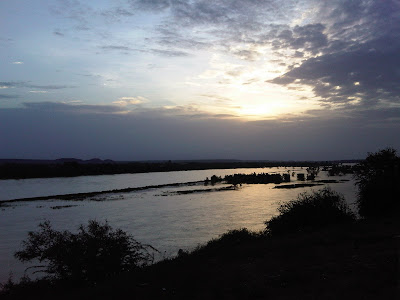Issouf and his family have joined more than 300 others in his neighbourhood in the capital, Niamey, taking shelter in a youth centre. They have little with them. And their main means of livelihood – growing vegetables to sell in the market – has also been wiped out by the heavy rains which have caused the worst flooding of the Niger river for more than eighty years.
“We were so happy to have rains in Niger,” he told me. “When we have rain, we can plant. Our gardens can grow and that helps us to have something to eat and sell. But when the rains came last week, water flooded everywhere. The protection barriers just collapsed.
“We lost everything, our house, our garden, clothes and other small things. We had 15 plots for vegetables… and we lost all of that.
“Its Ramadan now – it should be the busiest time of the year for us, because everyone is going to the market for shopping. I think we lost 150,000 CFA when our gardens were destroyed,” he said.

At this time of the year, most Nigeriens, like Issouf, would be praying for more rain so their crops could grow stronger. Erratic rains and drought-like conditions over the past two years have been one of the main causes of the current food crisis in Niger and many parts of the Sahel region – with around 50% of the population in Niger facing severe hunger because of failed crops.
Now the rains have come and in some cases, they’ve come with fury. Parts of the country have been hit by intense downpours and flooding, destroying houses, roads, bridges and killing thousands of animals. The UN said that more than 67,000 people have lost their homes in the past week alone and six people have been killed since the severe rains started at the end of July.
The River Niger – which flows through nine West African countries – has reached its highest level in more than 80 years. In the Nigerien capital, Niamey, more than 6,000 people were affected when the river burst its banks, destroying homes, and flooding vegetable gardens and rice fields.
Oxfam is responding, helping to provide hygiene and cleaning kits, installing water storage tanks and connecting communities to water systems.
But it’s not just the capital that has been affected by serious flooding. In several regions, the rains have washed away roads and bridges, destroyed peoples’ precious crops and killed thousands of livestock.
In the village of Kazoé, in Zinder region, I saw just how severe things have been. It’s been about two weeks since the village was hit by heavy floods. One hundred and eighty houses were destroyed; more than 1,200 sheep killed; and 135 gardens and 30 hectares of fields flooded.
Our journey to the village – normally a short 45 minute drive from Goure province – took us more than two and a half hours because roads and bridges had been washed away.
Oxfam and its partner, AREN, have been distributing food supplied by the World Food Programme to communities in the province. “It was all supposed to be finished in four days,” said Mai Abdou, who is in charge of the operation. “But, two weeks later, we still haven’t finished. It’s all because of the heavy rains. Logistically, things have been very difficult. One village was even cut off by the rains for a week,” he told me.

The rains have come early this year. The worry is that more flooding will hamper the delivery of much-needed aid to desperate communities. There are also fears that floods will bring water-borne diseases, increase the risk of malaria and diarrhoea putting the most vulnerable, particularly young children under five, already severely weakened because of lack of food, at further risk.
After a long drought, the rains were supposed to bring hope. But, in many areas, it’s only adding to peoples’ misery.









